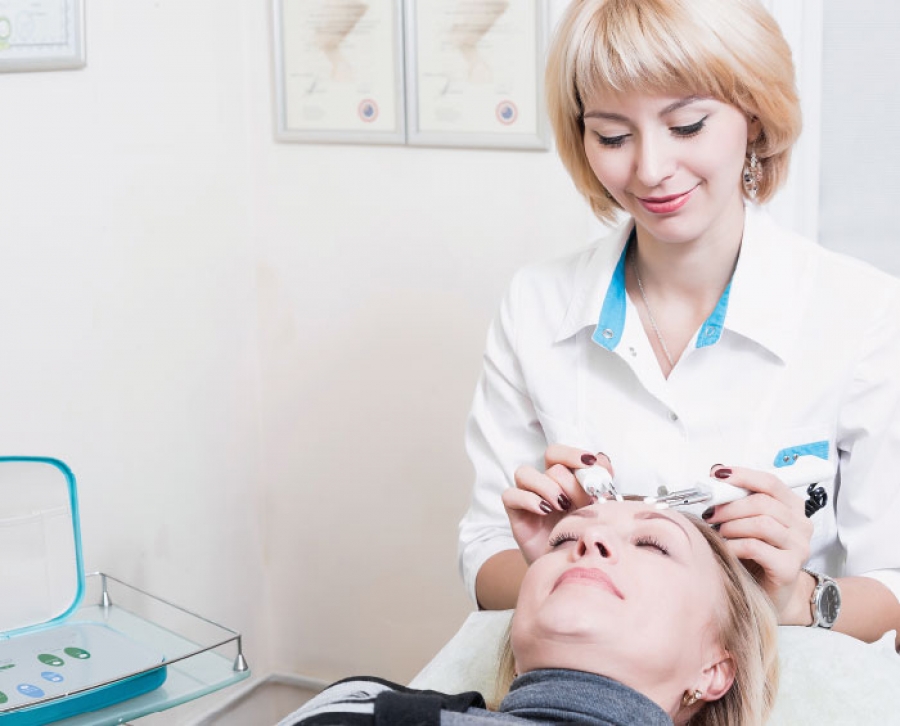There has been some controversy and confusion regarding cosmetic skin care in medical settings that include dermatology and cosmetic surgery. The old way of thinking for most practitioners in the medical community is that medicine and cosmetics are separate entities and should be kept that way. Skeptics often asked why someone would need to see an aesthetician if physicians diagnosed and treated the skin medically. It had become somewhat of a conflict; the majority of physicians thought that non-prescription topical skin care was unnecessary and hiring an aesthetician would be a waste of time. What would superficial skin care do to help medical procedures or prescriptive medicine?
Opportunely, this thinking started to change when medical spas became popular in the late 1990s. Medical spas offered a larger variety of treatments to patients, including facials with the aesthetician and fillers with a physician. They also provided non-invasive medical treatments with the added benefit of boosting results in a relaxing setting. Today, with the movement toward health and wellness, even more medical professionals see the benefit of maintaining the health of the skin by providing preventative skin care services.
Medical professionals, depending on their specialty, are meant to treat disease, disorders, dysfunctions, and abnormalities; aestheticians are meant to cosmetically enhance and alleviate conditions of the skin. When a combination of these treatments is implemented correctly, clients ultimately obtain the best results. Many physicians have come to realize that skin care is an important and recognized adjunct to cosmetic surgery and dermatology. Licensed aestheticians that have continued their education through advanced training can have a great impact on the success of a practice and care of the patient. On the other hand, when aestheticians were penetrating the medical field at a rapid rate without specialized training, some practitioners started to see them as impractical. Another reason for this negative view was due to aestheticians making false claims about cosmetic treatments and/or giving medical advice. This behavior is beyond the scope of practice for aestheticians, as well as unethical. It is unfortunate that some medical spas or practices do not follow regulations, leading to stricter laws that can ultimately effect what aestheticians can and cannot do. Some of these actions may be due to a lack of understanding, but there are several resources and organizations that can help.
 EDUCATION
EDUCATION
Knowledge of cosmetic and medical procedures was, at one time, only necessary to those actually working in a medical setting. With the increase in these procedures, it is something that all aestheticians need knowledge on to treat clients safely. Although basic training on cosmetic medicine is necessary for all skin care professionals, there is a higher level of education needed for those actually working in a medical setting. Training for a medical setting must include in-depth knowledge of cosmetic medical procedures, including indications, contraindications, possible reactions, and pre- and post-care for commonly performed treatments. Advanced training on cosmetic medical procedures does not imply that aestheticians can perform these procedures; this training is meant to inform them of what they can and cannot do to safely enhance and maintain results. Without an understanding of the treatments themselves, how could one thoroughly comprehend the skin care needs surrounding them?
PROFESSIONALISM AND ETHICS
To succeed as a skin care professional, regardless of the setting, maintaining the highest level of professionalism is required. There are core professional ethics that must be followed, the first of which is to always do what is best for the client. Choosing the best treatment for the client's well-being is a trait that will prove beneficial to an aesthetician's career and serve them well on a client-by-client basis, no matter the workplace setting. Professionals working in a medical setting are held to even higher standards than those working at a spa due to medical regulations and standards of care. Good bedside manner is essential for any service provider, but medical patients often need extra comfort and sensitivity. This characteristic is especially important because invasive procedures can be distressing for patients. More often than not, the patient becomes a loyal client and trusts the aesthetician because of the comfort and help they received during their office visits. Skin care professionals often gain more credibility when working under the direction of a physician. Physicians are less apt to offer what is not clinically proven; therefore, aesthetic treatments and product offerings become validated in the client's mind. Clients also think of physician recommendations for skin care treatments as similar to a prescription.
REGULATIONS
The growth of medical aesthetics, which is not a legally recognized term, has led to state regulatory boards being forced to determine who can perform specific treatments safely and which devices licensees can use. The way the rules and regulations are interpreted can be confusing. Licensing regulations differ per state, making it difficult to keep up with and, sometimes, interpret right from wrong. When working in a medical setting, these regulations must be followed closely for stability of the aesthetics license. Any treatments done outside the aesthetics scope of practice when working under licensure can result in fines or the revoking of the individual's license. These regulations do not only include aestheticians, but all licensed professionals. No matter the region, regulations can be unclear, which has made it difficult to know where aestheticians end and assisting a physician begins. Advancements in education and strides made by industry organizations are working toward clearly defined roles that lead to medical providers and aestheticians working together for a standard of care. When professionals understand their scope of practice and the role in the client's well-being, there is benefit to everyone involved.
BENEFITS TO PHYSICIANS
Two of the top aesthetic procedures, according to the American Society of Facial Plastic Surgery, are microdermabrasion and chemical peels. These treatments are most commonly performed by aestheticians – in some states the regulations may say superficial microdermabrasion and chemical exfoliation versus peel. This statistic clearly indicates the value of the skin care professional to the medical profession. This demand results in a number of physicians hiring aestheticians to offer these aesthetic treatments, as well as being available for other skin care services. Another role of the aesthetician in a medical office is to help with skin care before and after surgery, including product recommendation. They also play a less-celebrated, although crucial, role in managing the patients' comfort and personal well-being, which can be the greatest benefit for patients. Aestheticians can perform initial skin care consultations while prepping the client's skin prior to their treatment. During the treatment, aestheticians can provide comfort to the patient or hold pressure on an area that may be bruised, as well as apply post-treatment products and assist the physician as needed. At the end of a treatment session, they can educate the patient on how to properly care for their skin to get the best results from their treatment.
Homecare should support in-office treatments. Recommending the correct skin care regimen, including pre- and post-care, can be beneficial; it lessens the chance of side effects and provides results that may be more prominent. The healthier the skin, the faster it can repair itself after treatment. Product use is especially important following invasive treatments, like deep laser resurfacing. If the skin is not cared for properly when the client leaves the office, adverse reactions, including infections, discoloration, and even scarring, may occur. The aesthetician can also make the most of their time by preparing the treatment room, walking patients back to their appointed room, and taking pictures. Aestheticians tend to spend significant time with patients, freeing up the physician's time to see more patients. The physician's time is the most valuable asset of a practice. The number of cosmetic and medical providers increases daily with internal medicine; cultivating client relationships with multiple staff members increases the chances of maintaining clientele.
DELEGATION OF MEDICAL PROCEDURES
In several states, aestheticians need to choose between working as an aesthetician performing aesthetic services or doing more advanced treatments under the direction of a physician, forgoing working under their aesthetic license and working as an assistant to the physician. Of course, being educated on the skin will always prove beneficial to those working in the cosmetic industry. This knowledge is why aestheticians became valuable to medical practices that worked on cosmetic matters from the beginning. Shortly after, aestheticians started calling themselves medical aestheticians. This title may give the impression that medical procedures are within the scope of an aesthetics licensure when, in fact, they are not. When a physician can delegate a medical service to anyone they see fit, which is the case in several states, they will typically look to those who are knowledgeable in skin care. For example, if a physician were to call on assistance with a cosmetic procedure, would they choose the practice manager, the receptionist, or someone who is highly skilled on skin care practices?
If professionals work together and advocate for a higher quality of education, others see them as more valuable. With state regulatory boards defining what is acceptable practice and pushing for standardized training, roles become more defined throughout the industry. Aestheticians should come together to work on a clear definition of mandated medical aesthetics.
Susanne Warfield, from The National Coalition of Estheticians, Distributors/Manufacturers and Associations (NCEA), states: "The issues of 'who' can do 'what' in a medical setting is still blurred. In some states, state regulatory boards cannot enter into a medical setting to inspect the aesthetician licensee when the medical setting does not hold a cosmetological establishment license. Alternately, an aesthetician cannot hold themselves out to 'be an aesthetician' when they work in a medical setting. Another misnomer is that the aesthetician works 'under the physician's license.' Rather, if the aesthetician cannot perform duties as an aesthetician, then they MUST work for the physician and be DELEGATED TO perform the procedure. In other words, the patient must be seen by the physician first to determine treatment; then they would delegate to an assistant."
 Terri A. Wojak, education director at True U Esthetics and True U Laser, is a highly sought-after professional with 20 years of experience in the aesthetic industry. She is a respected authority on skin care in a medical setting, education, and business development on multiple levels. Wojak has built 30 individual courses based on skin care in a medical setting. Wojak has published two books, "Aesthetics Exposed: Mastering Skin Care in a Medical Setting & Beyond," and "Mastering Medical Esthetics." She has trained over 3,000 aestheticians and medical professionals on the importance of incorporating skin care into cosmetic medicine.
Terri A. Wojak, education director at True U Esthetics and True U Laser, is a highly sought-after professional with 20 years of experience in the aesthetic industry. She is a respected authority on skin care in a medical setting, education, and business development on multiple levels. Wojak has built 30 individual courses based on skin care in a medical setting. Wojak has published two books, "Aesthetics Exposed: Mastering Skin Care in a Medical Setting & Beyond," and "Mastering Medical Esthetics." She has trained over 3,000 aestheticians and medical professionals on the importance of incorporating skin care into cosmetic medicine.
